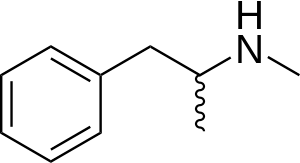Structural analog
In chemistry, a structural analog, also known as a chemical analog or simply an analog, is a compound having a structure similar to that of another one, but differing from it in respect of a certain component.[1][2][3]
It can differ in one or more atoms, functional groups, or substructures, which are replaced with other atoms, groups, or substructures. A structural analog can be imagined to be formed, at least theoretically, from the other compound.
Despite a high chemical similarity, structural analogs are not necessarily functional analogs and can have very different physical, chemical, biochemical, or pharmacological properties.[4]
In drug discovery either a large series of structural analogs of an initial lead compound are created and tested as part of a structure-activity relationship study[5] or a database is screened for structural analogs of a lead compound.[6]
Chemical analogues of illegal drugs are developed and sold in order to circumvent laws. Such substances are often called designer drugs. Because of this, the United States passed the Federal Analog Act in 1986. This bill banned the production of any chemical analogue of a Schedule I or Schedule II substance that has substantially similar pharmacological effects, with the intent of human consumption.
Examples
| Alcohols |
|---|
| Silanol, a structural analog of methanol |
|
See also
References
- ↑ Willett, Peter, Barnard, John M. and Downs, Geoffry M. (1998). "Chemical Similarity Searching" (PDF). Journal of Chemical Information and Computer Science. 38 (6): 983–996. doi:10.1021/ci9800211.
- ↑ A. M. Johnson; G. M. Maggiora (1990). Concepts and Applications of Molecular Similarity. New York: John Willey & Sons. ISBN 0-471-62175-7.
- ↑ N. Nikolova; J. Jaworska (2003). "Approaches to Measure Chemical Similarity - a Review". QSAR & Combinatorial Science. 22 (9–10): 1006–1026. doi:10.1002/qsar.200330831.
- ↑ Martin, Yvonne C., Kofron, James L. and Traphagen, Linda M. (2002). "Do Structurally Similar Molecules Have Similar Biological Activity?". Journal of Medicinal Chemistry. 45 (19): 4350–4358. doi:10.1021/jm020155c. PMID 12213076.
- ↑ Schnecke, Volker & Boström, Jonas (2006). "Computational chemistry-driven decision making in lead generation". Drug Discovery Today. 11 (1–2): 43–50. doi:10.1016/S1359-6446(05)03703-7. PMID 16478690.
- ↑ Rester, Ulrich (2008). "From virtuality to reality - Virtual screening in lead discovery and lead optimization: A medicinal chemistry perspective". Current Opinion in Drug Discovery & Development. 11 (4): 559–68. PMID 18600572.
External links




